





Coco
In addition to amazing taste the coco contains also the mass of useful substances.
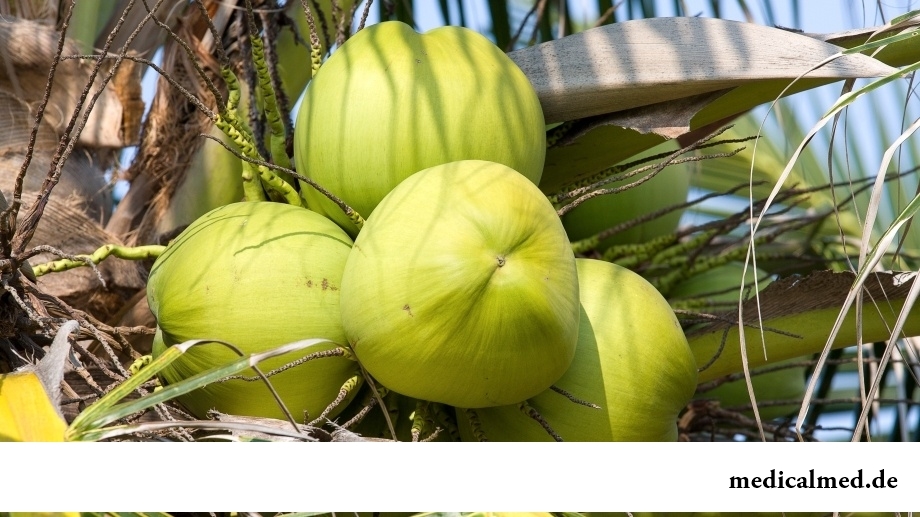
Description
The coco, or as it is called still, coconut is a fruit of a coconut palm tree, the plant relating to family Palm. The name of a fruit comes from the Portuguese word coco which is translated as "monkey", and is connected with existence on its surface of the spots doing it similar to a muzzle of a monkey. Scientists consider that the homeland of a coco is the region of Southeast Asia. Now it is eurysynusic in tropical areas of both hemispheres. Preferential, are engaged in cultivation and export of cocoes in Indonesia, India, Thailand, Philippines, Sri Lanka, Brazil and in a set of the states located on the Pacific coasts.
Generally, a fruit of a coconut palm tree – not nut, and just a stone fruit of rounded shape which diameter makes from 10 to 30 cm. It is covered with a thick layer of fibers and weighs to 2,5 kg. At us in shops the stone fruit which is already cleared of fibers which outside cover consists of a firm shell with three "eyes" - the soft sites located nearby from each other is on sale. Inside there is a soft cover – edible pulp of a coco which is also called a copra, having white color and coconut water – slightly sweetish liquid.
Eat coconut milk and pulp. Pulp is used in a fresh or dried look. It is added to various salads, soups, main courses and confectionery. From pulp also receive coconut milk and oil of a coco which is widely used in cookery and in preparation of various cosmetics.
Structure and caloric content of a coco
100 g of pulp of a coco contain 44,6 g of water, 36,5 g of fats, 4,8 g of carbohydrates, 3,9 g of proteins and 9 g of cellulose; vitamins: groups B, E, C, PP, N; macrocells: sodium, calcium, sulfur, potassium, magnesium, chlorine, phosphorus; microelements: fluorine, selenium, zinc, iodine, manganese, iron, copper.
Caloric content of a coco is quite high and makes 364 kcal on 100 g of a product.
Useful properties of a coco
The coco, and also the milk and oil of a coco received from it, have multiple useful properties:
- Normalize work of a thyroid gland;
- Improve work of a liver and the alimentary system;
- Pulp of a coco and milk are capable to recover well forces and to improve sight;
- Oil of a coco feeds and strengthens hair, improves their general state and outward;
- Relax muscles and help at diseases of joints;
- Coconut milk well satisfies thirst;
- Oil of a coco and milk favorably influence a condition of skin, smooth wrinkles, humidify and feed it;
- Increase immunity and body resistance to infections, reduce adaptability of viruses to antibiotics;
- Help an organism at catarrhal diseases and flu, diarrhea, diseases of a gall bladder, AIDS, herpes;
- Reduce risk of atherosclerosis and other diseases of cardiovascular system, and also oncological diseases and degeneratsionny processes;
- Possess wound healing, antimicrobic, vermifuge, antiviral action.

Thanks to the lauric acid (the main fatty acid which is a part of breast milk) which is contained in pulp useful property of a coco is decrease in cholesterol in blood.
Despite numerous useful properties of a coco, it needs to be avoided with individual intolerance to any component which is its part.
According to opinion of many scientists, vitamin complexes are almost useless for the person.

What is in our understanding weeds? It plants which are considered to be suitable only for compost pits and feeding жи...
Section: Articles about health
Statistically, pathologies of a thyroid gland in the world more than 500 million people have. Failures in work of this body lead to heavy disbolism, development of heart diseases, vessels, a reproductive and nervous system. In hard cases excessive...
Section: Articles about health
One of the major chemical processes happening in a human body are oxidation reactions. They go with participation of fats and carbohydrates which we receive from food, and the oxygen getting to us from air. A main goal of such reactions is obtaining the energy necessary for life activity. Unfortunately, as a result of these processes dangerous by-products – so-called free radicals are allocated. To minimize harm which they can cause to the person neo...
Section: Articles about health
At this plant there are a lot of names: tuberiferous sunflower, Jerusalem artichoke, solar root, earth pear. Contrary to spread...
Section: Articles about health
The advantage of swimming for the person is so high that this sport is not only the most popular, but also is widely applied in medicine and rehabilitation processes. If you look for for yourself the occupation allowing pleasantly and to spend time, then swimming with advantage...
Section: Slideshow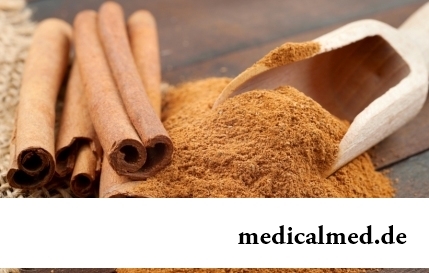
Ayurveda - the most ancient tselitelsky practice which came to us from India. It represents the doctrine about maintenance of physical, psychological and moral health of the person by means of the complex of procedures including a diet, cleaning of an organism, breathing exercises, massage, and in case of a disease - and medicinal therapy. The healers practicing Ayurveda assign very important part to spices, and at the heart of Ayurvedic drugs, as a rule, there are they. It is considered that spices not of t...
Section: Articles about health
The summer of this year in Russia was very ambiguous. Regions suffered from a merciless heat, from pouring rains, from times...
Section: Articles about health
All got used long ago that, having addressed the plastic surgeon, it is possible to modify natural parameters of a figure or to minimize the damages put to appearance with ruthless time. Many people (preferential women) worldwide е...
Section: Articles about health
Life of the modern woman is very difficult. Opportunities to realize itself are wide: it not only education and career, but also the most various hobbies from sport before needlework. It is not less important to build private life, paying an attention maximum to children, the husband, parents, friends. For all these affairs there is catastrophically not enough time therefore each of us tries to cut down as far as possible its expenses on necessary, but not the most fascinating housework. With it we are successfully helped by means...
Section: Articles about health
Smack in a mouth can arise in the natural way – as a result of lack of morning hygiene or reception of the corresponding food. Odn...
Section: Articles about health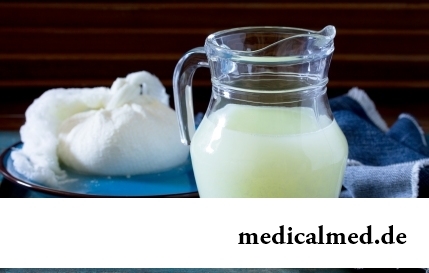
Milk and products of its processing by right occupy one of the main places in a diet of the modern person. They contain proteins, necessary for normal life activity, fats, vitamins and microelements, and are an important part of various medical diets....
Section: Articles about health
The sclera and mucous membrane of an eye are intensively supplied with blood vessels which problem - to saturate nervous tissues of body with nutrients and oxygen. In a normality vessels are almost not noticeable, however at their expansion (owing to thinning of walls) become visible, painting a sclera in red color. Quite often red eyes - the signal of any trouble in an organism caused as external irritants, allergens, and diseases which need in about...
Section: Articles about health
The mankind knows that some toxins at intake in the minimum quantities have therapeutic effect...
Section: Articles about health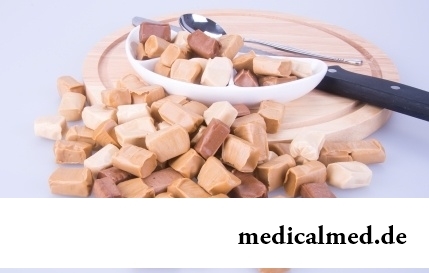
Food with the increased content of sugar is attractive to most of people - it is scientifically confirmed fact. Business here not in intemperance or dissoluteness: the sweet food is associated since childhood with feeling of rest and safety which is felt by the kid, to...
Section: Articles about health
Many of us, probably, noticed more than once that from intellectual loadings at some point the brain as though "overheats" and "assimilation" of information is strongly slowed down. Especially this problem urgent for persons of age becomes more senior than fifty years. "Already badly I think", "the head will burst now", "memory as if is disconnected" - here that wants to be told at the time of information overload....
Section: Articles about health
Coffee – favourite drink of many. For the last decades it more than once already declared very harmful, extremely useful and even...
Section: Articles about health
Helminthosis is one of the most widespread diseases. Statistically, any species of helminths infected every third inhabitant of the planet. Most of specialists even consider these data strongly underestimated: some uninvited "cohabitants" of N...
Section: Articles about health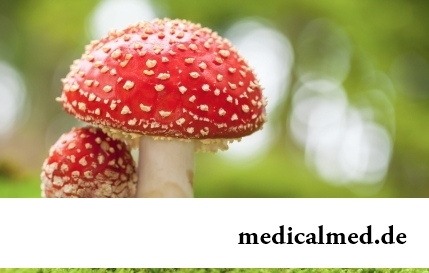
Mushrooms - the surprising inhabitants of our planet having a set of wonderful qualities. Thanks to one of them, a mold mushroom of Penicillium notatum, the first natural antibiotic - penicillin was received nearly 80 years ago. The mankind is obliged to this opening by millions of saved lives....
Section: Articles about health
On the head of the person about one million hair follicles, or as they are called still, hair bulbs are located. At the moment he is born...
Section: Articles about health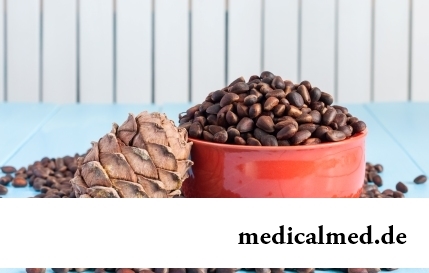
The hysteromyoma is diagnosed more than at a third of women 35 years are more senior. This high-quality new growth which at early stages successfully resolves by means of medicines. It is necessary to resort to an operative measure only in those a case...
Section: Articles about health
History of use of an anesthesia during operations contains more than 160 years. Annually in the world hundreds of thousands of surgical interventions during which to patients the substances immersing them in a dream and saving from pain are entered are carried out. Using an anesthesia many myths and delusions are still connected. It is worth getting acquainted with the most widespread of them....
Section: Articles about health
(Xerostomia) many people consider feeling of a xerostomia small and easily removable inconvenience. This delusion...
Section: Articles about health
Stability of a hormonal background is one of the most important conditions of preservation of health of the woman. At the same time endocrine system – the thin device extremely sensitive to any external influences. Changes of an image жиз can become the reason of hormonal failure...
Section: Articles about health
So, you resolved to lose weight. And now you try to understand what to begin with: from exercise stresses or a diet? And how to make that process of weight loss did not give you an inconvenience, and, on the contrary, brought joy?...
Section: Slideshow
Several decades ago the basil (the district khan, реан, Reagan) was considered as a part of the Caucasian or east cuisine, but today it is strong for...
Section: Articles about health
Traveling all over the world, many try to try the most exotic dishes of national cuisines. There is even a so-called gastronomic tourism which, according to gourmets, not only allows to receive new feelings, but also is capable to show life the friend...
Section: Articles about health
In consciousness of our many compatriots idea that folk remedies if are no more effective, than medicinal "chemistry" strongly took roots, then are precisely less harmful. Unfortunately, it is not always fair: some methods of treatment consecrated with "century national experience" can work so on the patient that it will need urgent intervention of physicians....
Section: Articles about health
